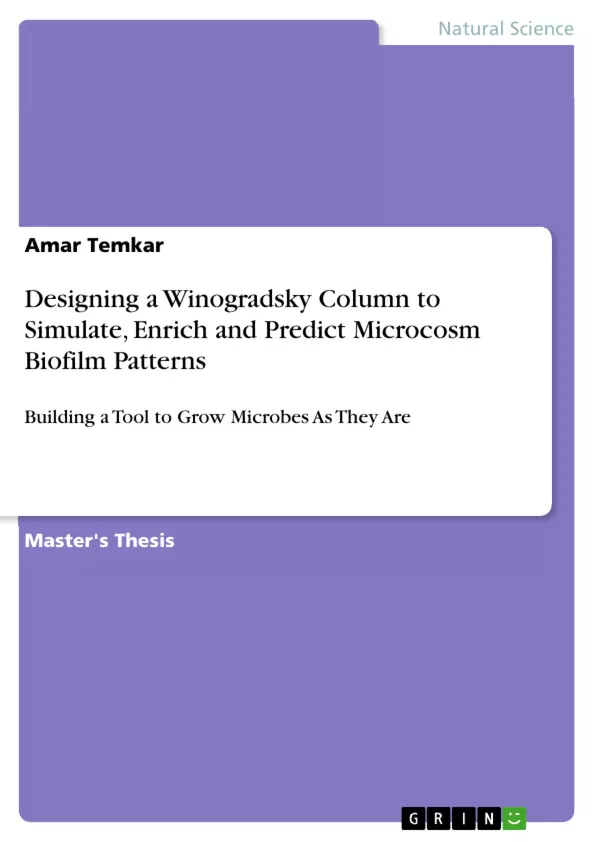Variations of Winogradsky Columns were designed, i.e. soil texture, light, salts, hard substrates, carbon and energy sources, Winogradsky Tanks to simulate wind and waves, Winogradksy Fuel Cells to monitor the redox potential of the biofilms, High Pressure Winogradsky to simulate water depth, etc. The influence of the Winogradsky’s environment on the biofilm patterns and vice versa were studied. The phenomenon of microbial succession was studied. The patterns were tracked by making Winogradsky Maps and mathematical data obtained by taking the Equivalent Weight of the pattern cutouts. Regression Equations were assessed to individual biofilm patterns. These equations were tested to predict the patterns. Finally a design for an all-environment simulation Winogradsky Column was laid. Innovative setups to simulate deep sea pressure were also done to see the consequent biofilm patterns.
Inhaltsverzeichnis (Table of Contents)
- Introduction
- Review of Literature
- Materials and Methods
- Results
- Discussion
- Summary
- Bibliography
Zielsetzung und Themenschwerpunkte (Objectives and Key Themes)
The objective of this project work is to design and build a Winogradsky column, a microcosm simulating natural aquatic environments. This column is intended to mimic the interaction of microorganisms and nutrients along a vertical gradient, establishing a miniature ecosystem that showcases the interplay of various microbial communities.
- Simulating Aquatic Microcosms
- Microbial Biofilm Formation
- Nutrient Gradients and Microbial Interactions
- Phototrophic and Chemotrophic Sulfur Oxidizers
- Microenvironmental Dynamics and Community Development
Zusammenfassung der Kapitel (Chapter Summaries)
- Introduction: This chapter provides an overview of the Winogradsky column, highlighting its significance as a model system for studying microbial communities. It discusses the importance of nutrient gradients and microbial interactions in aquatic environments, setting the stage for the project's aim of designing and constructing a functional Winogradsky column.
- Review of Literature: This chapter delves into existing knowledge regarding the Winogradsky column and its application in studying microbial ecology. It examines previous research on the development of microbial communities within the column, exploring the role of various microbial groups, including sulfur oxidizers and photosynthetic organisms.
- Materials and Methods: This section outlines the step-by-step process of constructing and maintaining the Winogradsky column. It describes the materials used, the experimental setup, and the methods employed to monitor the progress of microbial community development within the column.
- Results: This chapter presents the findings of the study, focusing on the observed changes in microbial populations and their distribution along the vertical gradient of the Winogradsky column over time. It likely showcases the emergence of distinct microbial zones and the establishment of a stable microbial ecosystem within the column.
Schlüsselwörter (Keywords)
The project focuses on microbial ecology, Winogradsky column, microcosm, biofilm formation, nutrient gradients, sulfur oxidizers, phototrophic microorganisms, chemotrophic microorganisms, microbial communities, and ecosystem dynamics.
- Quote paper
- Amar Temkar (Author), 2006, Designing a Winogradsky Column to Simulate, Enrich and Predict Microcosm Biofilm Patterns, Munich, GRIN Verlag, https://www.hausarbeiten.de/document/184259


